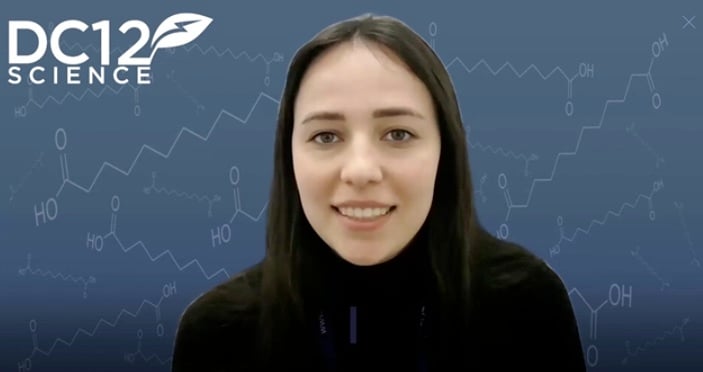Learn More About DC12 and DiCarbs


DC12 vs. Ketones?
Prof. Giltrude Mingrone explains the difference between DC12 and Ketones
Play Video


DC12 and Flexible Energy
Biotechnologist Sara Russo explains how DC12 helps promote metabolic flexibility
Play Video
What is a Macronutrient and why is DC12 considered to be the "5th"?
Macronutrients are nutrients that provide calories or energy and are required in large amounts to maintain body functions and carry out the activities of daily life. Fats, carbohydrates, proteins and now Ketones are considered macronutrients.
DC12 provides clean energy-dense fuel (7.2 kcal per gram) almost double that of carbohydrates (4 kcal per gram) and a little less than fat (9 kcal per gram) and is now considered to be the 5th macronutrient.
What is a DiCarb?

Medium- and long-chain dicarboxylic acids (DiCarbs) are present in higher plants and animals, deriving from the ω-oxidation of fatty acids. In higher plants, DiCarbs are components of natural protective polymers, such as cutin and suberin, a support biopolyester that waterproofs the leaves and fruits, regulating the flow of nutrients and minimizing the harmful impact of pathogens.
A dicarboxylic acid has a chemical structure represented by the general formula "HOOC-R-COOH", where "R" can be an alkyl, alkenyl, or alkynyl group, and the key feature is the presence of two carboxyl groups (-COOH) within the molecule, giving it acidic properties; essentially, it's an organic compound with two (thus “di”) carboxylic acid functional groups attached to a carbon chain. DiCarbs can have different chain lengths based on the number of carbon atoms between the two carboxyl groups. By definition, “DC12” is a DiCarb with 12 carbon atoms.
How does DC12 help maintain metabolic health
DC12 promotes metabolic flexibility, which allows the body to switch from burning glucose to burning fat for fuel. It has been shown to not just maintain insulin in already healthy ranges, but to also re-sensitize cells to insulin. This is fundamental to human health, particularly for those who’ve been impacted by the Standard American Diet. The potential implications of better insulin sensitivity in humans include, but aren’t limited to healthy aging, exercise performance, weight management and overall wellbeing.
How does DC12 provide "clean" energy during workouts?
When we exercise, we first burn glucose, then glycogen that is stored in muscle, and then fat. DC12 is a cleaner burning and more energy-dense alternative fuel to glucose. DC12 is bound to either sodium or potassium to
create “super electrolytes” functionalized for burning fat and improving endurance. It is rapidly oxidized as energy in peroxisomes and mitochondria and cannot be stored as fat. These features are dramatically different from fats like MCT which can be stored as fat. DiCarbs® are a fast-acting and non-storable energy source that animal studies have shown an increase metabolic rate (aka “calorie burning”) and protection against weight gain.
How does DC12 support weight management?
DC12 has been shown in animal models to increase metabolic rate (metabolism/calorie burning) and improve fatty acid oxidation (burn fat). When combining a higher metabolic rate and fatty acid oxidation with maintaining insulin levels in already health ranges, it makes for a potentially powerful tool in weight management.
How can DC12 help with hydration?
Minerals such as potassium and sodium are lost when you sweat during physical activity. Ingesting these minerals can help the balance of water throughout the body, thereby improving hydration.
The advantage of sodium DC12 over sodium chloride (table salt), is that sodium DC12 functionalizes sodium to add energy and muscle performance components. Sodium DC12 also avoids any potentially negative association with sodium chloride (table salt) and blood pressure.
What is ADP and why is it so important?
Adenosine triphosphate (ATP) is the source of energy for use and storage at the cellular level.
With DiCarbs like DC12, ATP is generated during mitochondrial and peroxisomal oxidation. While mitochondria and peroxisomes are found in multiple organs, muscle is rich in mitochondria and the liver is rich in peroxisomes. DC12 plays a crucial role in supplying energy between these two incredibly important organs—muscle and liver. Because insulin sensitivity starts in the muscle, and insulin sensitivity in the liver is fundamental to fatty acid oxidation, DC12’s capacity to support normal insulin sensitivity and provide a new source of energy is a revolution in wellness and exercise performance.
Want To Know More?
Please contact us below and we'll get your questions answered.
